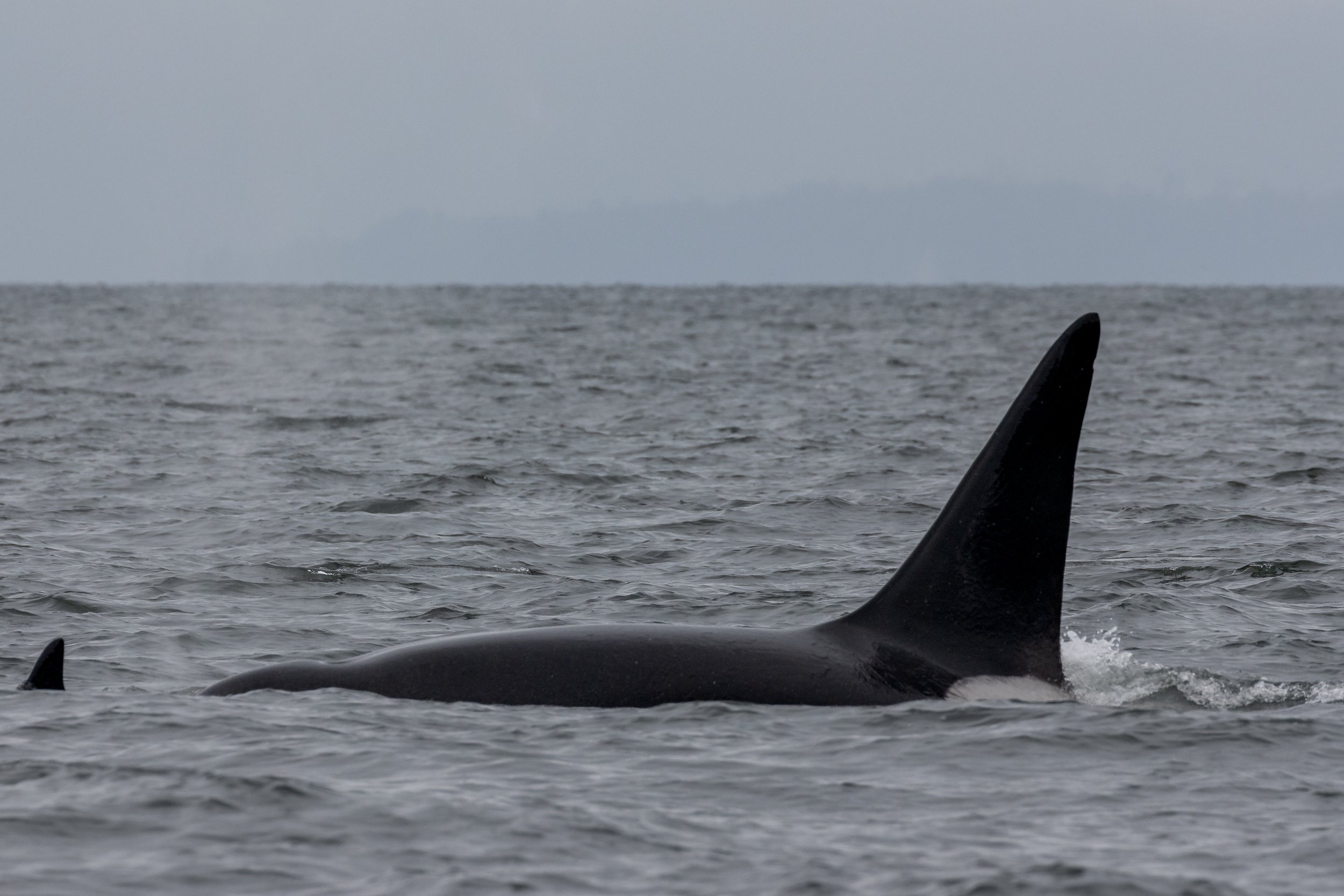June 19, 2023, 3:30 PM - T046Bs and T085s continue their adventures together
This afternoon we met up with the same group of transient orcas that we saw during the morning tour! When we found them this time, they were out in the Strait of Georgia on the eastern side of Gabriola Island. The afternoon T-party included the following whales:
T046B Raksha ♀ (1988)
T046B2 Akela ♀ (2008)
T046B3 Sedna ♀ (2011)
T046B4 Quiver ♀ (2013)
T046B6 Sol ♀ (2019)
T046B7 (2023)
T085 Eve ♀ (~1977)
T085B Ali ♂ (1995)
T085D Findlay (2014)
T-parties occur when multiple matrilineal family pods spend time together, travelling, hunting and even mating. Each pod is led by the matriarch, who is the eldest female and mother of the group. Today, there were two matriarchs present: T046B Raksha and T085 Eve. Female orcas can reproduce by the time they reach 10-13 years old and usually have a calf every 3-5 years until they are about 50 years old. Around their 50s is when female orcas will go through menopause and stop reproducing, though they will remain the leader of the pod, passing on their knowledge and many years of hunting and vocalizing of their pod’s unique dialect. Matriarchs that are in their later years have been seen helping their daughter’s children learn everything there is to know about life travelling and hunting as a family pod. The life expectancy of female transient orcas is 80-90 years, so the matriarch will continue to teach the rest of the pod members for many years past her reproducing years. Orcas are one of only three species that we know go through menopause, with the other species being humans and short-finned pilot whales.
Transient isn’t exactly an accurate term for these orcas, as the same pods are seen travelling within the same area multiple times throughout the year, and sometimes staying in the same location for a whole day. However, when constantly travelling, transient orcas can travel upwards of 100 kilometres in one day.
During the time that transient orcas are travelling, often they are hunting. Each orca needs to eat approximately 300 lbs of food each day. An adult harbour seal weighs up to 285 lbs, so a pod of 9 whales would need to successfully hunt and eat a minimum of 9 harbour seals every day. Transient orcas also commonly feed on harbour porpoises and sea lions, though they have a preference for harbour seals. Luckily, we don’t need to worry about the harbour seal population dwindling, as there are roughly 100,000 harbour seals along the coast of British Columbia.
Harbour seals were spotted along Stinky Rock today, in lower numbers than usual. Spending as much time as possible on the rocks is a smart decision for them, as being in the water makes them vulnerable to orcas in the area that may be hunting for a harbour seal snack. Eventually, harbour seals will have to wiggle into the water to hunt. Harbour seals mainly feed on herring and other small fish species.
Also spotted on Stinky Rock today were some sleepy Steller sea lions. Sea lions are a lot larger and more efficient at moving than seals; sea lions are able to hinge their tail flippers, allowing them to use them as their feet as they move along rocks. Other features that set sea lions apart from seals are their external ear flaps and the loud noises that they produce.
Our last stop of the day was the Gabriola Island Bluffs. The sandstone along this stretch of Gabriola Island is the oldest on the island, at 74 million years old. Over the last 74 million years, the sandstone has been slowly eroded by wave action along the cliffside, creating pocketing and bubbling, The cormorants use these pockets as a base for their nests. They collect grass, leaves, twigs and seaweed to build these nests and then they will poop on their nests to glue the nesting material in place. Cormorants migrate to Mexico in the winter and then come back here in the spring and their hope is that they will have pooped on their nest enough that they won’t have to rebuild their nest very much when they come back here.
Photos this afternoon were taken by Marine Naturalist Aly Kohlman.
T046B2 Akela.
T085 Eve (left) and T046B3 Sedna.
T085B Ali (right) and friends.
T085 Eve (left) and T085B Ali.
T046B Raksha (left) and T046B6 Sol.
T046B2 Akela (left) and family.
T085D Findlay (left) and T085B Ali.
T085 Eve.
T046B6 Sol (left) and T046B Raksha.
T046B Raksha.
T085 Eve.
T085B Ali.
T085D Findlay.
T046B4 Quiver.
T085B Ali (front) and friends.
T085B Ali (front), T085 Eve (behind) and T046B4 Quiver (right).
T085 Eve.
T085B Ali.
A curious Harbour seal up on some seaweed.
Model material.
Can you spot the adult Bald Eagle and it Eaglet in this photo?
Keeping an eye out for danger.
Cormorants along the Gabriola Bluffs.
A Pigeon Guillemot with a snack.




























